 Sunday/Weekend
Sunday/Weekend
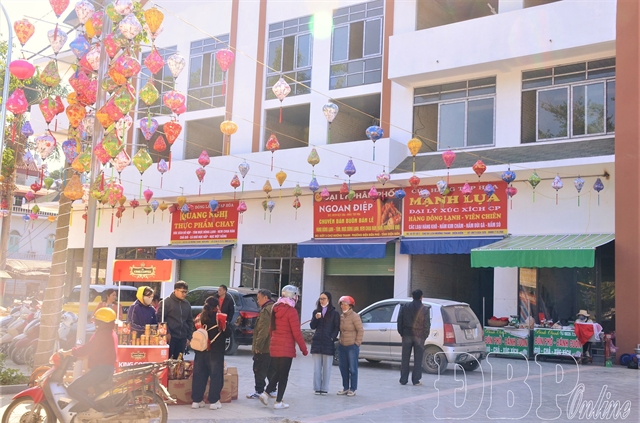
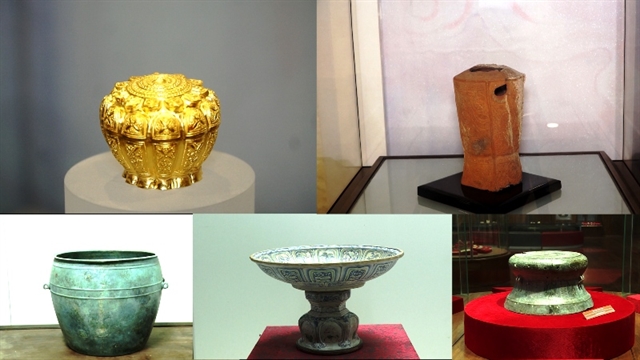 |
| Five national treasures are preserved at Quảng Ninh Museum. Photo baodantoc.vn |
HÀ NỘI - Behind every national treasure there are elaborate stories about the often arduous journey of discovering, excavating, and bringing it to the public. Then there is the considerable work involved in preserving and protecting its value, all taking considerable effort for museums and authorities.
Many of the country's national treasures, including artefacts of history, culture, and science dating back hundreds and even thousands of years, have not been looked after properly, according to museum officials and experts.
They are being eroded day by day, facing the risk of deterioration and damage after years of being stored in shabby warehouses, or in the corners of museums without adequate preservative measures and facilities.
While there is continuous talk of solving the issue, the problem is rarely properly addressed, and many of the country's most precious relics are being effectively left to rot.
Currently, the Hà Tĩnh Provincial Museum, for example, is simply displaying one of three cannons recognised as national treasures since 2013.
Nguyễn Thị Nhuần, the museum's communications employee, told Báo Văn Hóa (Culture Newspaper) that for many years, all the artefacts preserved at the Hà Tĩnh Museum had not had a real home for display, and there was no special space for vital national treasures.
Established in 1992, the museum was first located over 500sq.m at the site of the Uncle Hồ memorial area, but in 2018 it had to move to a new place in the provincial library.
Six years have passed, but it still has no official headquarters due to limited funding. A lack of financial sources has also made the problem of preserving and promoting the value of the national treasures even more difficult.
According to Nhuần, the museum's displayed cannon is one of three that the museum has invested in partially restoring, while the remaining two are still in storage awaiting funds.
The cannon is a "monumental" item, so it was exhibited right at the entrance of the museum. After being partially restored and inlaid with silver, it is now gradually showing signs of oxidation again. There is no introduction sign, only a red string around it to prevent people from getting too close.
“With a small fund for preservation work, the treasures are just cleaned every day by the staff. Degradation and oxidation are inevitable if they are not stored in appropriate conditions," said Nhuần.
The remaining two cannons are in an old warehouse with a corrugated iron roof, with temperature inside as high as in an oven.
"The warehouse has no fan, no air conditioner or dehumidifier to meet the standards required for proper conservation. It's so sad that national treasures are stored in poor conditions, but we, the museum staff, can do nothing to help," she added.
Director of Hà Tĩnh Museum, Đậu Khoa Toàn, said: "It is so sad. But now the museum can only wait and try to overcome any immediate difficulties. There is no other way."
Hà Tĩnh Museum is also preserving a bell from the Rối Pagoda, dating back more than 600 years, which was recognised as a national treasure in 2023.
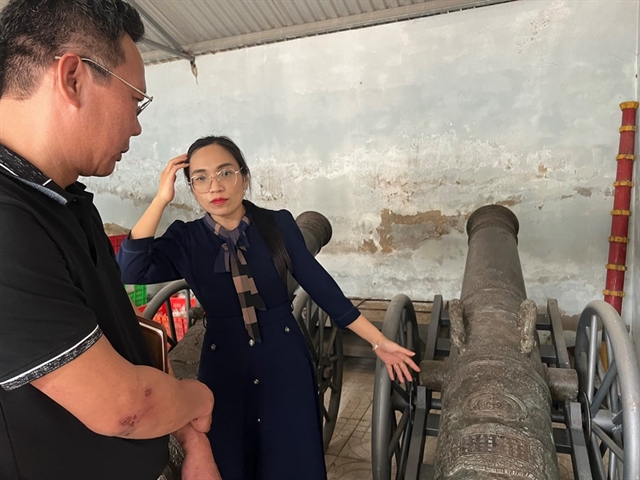 |
| One of the three cannons, recognised as national treasures in 2013, is preserved in a poor condition at the Hà Tĩnh Museum which is actually a temporary place in the provincial library. Photo baovanhoa.vn |
Discovered in relatively intact condition, the bell is the only unique original artefact discovered at the site of the pagoda in Cẩm Thịnh Commune, Cẩm Xuyên District.
However, the museum is facing increasing hardship in preserving and promoting the precious treasure. The bell is currently located next to the temporary display location of the cannon. Despite its special value, no surrounding protection and preservation measures have been taken, and there is not even an introduction sign.
Toàn said the provincial authority had paid attention and recently made a plan to build new premises for the museum, including allocating land, organising design competitions, and finding investment.
"Perhaps it is too perfectionist to expect a worthy museum to represent the province's cultural identity. Nevertheless, the goal is to have a museum or a cultural institution that meets all the requirements," he said.
Hà Tĩnh Museum has struggled for 32 years to find a financial source for upgrading its operations, but still has no proper headquarters.
"It is still not known when Hà Tĩnh Museum will end its homeless situation, and the desperately bad deterioration of over 13,000 artefacts will end."
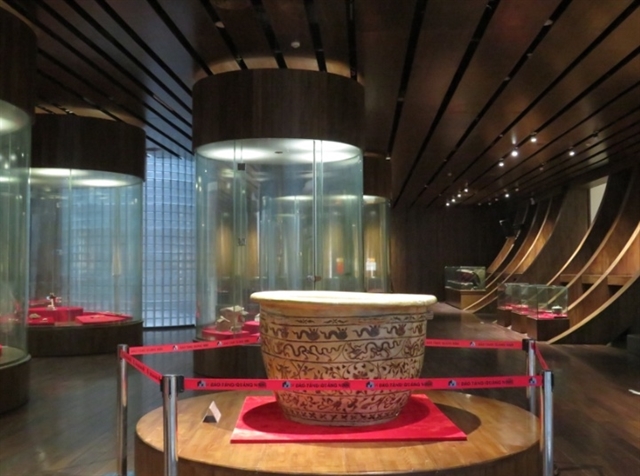 |
| The An Sinh brown-flower ceramic jar of the Lý - Trần dynasties was recognised as a national treasure in 2021 and is currently preserved at Quảng Ninh Museum. Photo baodantoc.vn |
Bắc Ninh Provincial Museum has been open for 25 years, and still does not have a permanent high-quality display space. The museum's Deputy Director Đỗ Thị Thủy told Báo Văn Hóa that as the museum itself still had no qualified spaces for exhibition, national treasures did not have any space to display their brilliance.
"It is a paradox that hinders the implementation of regulations on protecting, preserving and promoting the value of national treasures," Thủy said.
Among nearly 20 artefacts and groups of artefacts recognised as national treasures in the northern province of Bắc Ninh, two are kept at the provincial museum: a Xá Lợi Tháp Minh stele made of stone and the Hải Thượng Y Tông Tâm Lĩnh, an ancient medical woodblock book.
The book comprises 1,100 woodblocks stored on iron shelves. Many of them are good quality, but some will break due to the effects of weather.
“Every year we extract part of our career budget for preserving the treasures and preventing them from damage due to effects such as oxidation and termite destruction. However, we still do not have a special preservative scheme or a formal exhibition space to effectively promote their value," Thủy said.
In recent years, the Ministry of Culture, Sports and Tourism (MoCST) has urged local authorities to strengthen the protection, preservation and promotion of national treasures. It repeatedly emphasised the need to prioritise funding for renovation and upgrading display equipment.
However, the reality is that many museums have had to stand still because they do not have a standardised location for preserving and displaying artefacts due to a lack of funds. There are many complaints but little actual action.
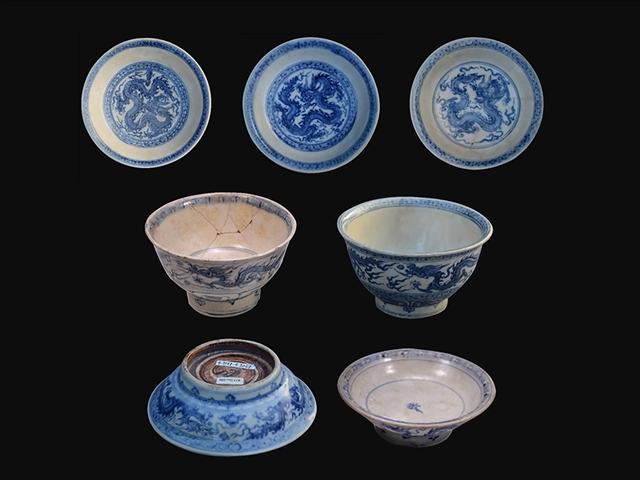 |
| A collection of blue flower ceramic bowls of the early Lê Dynasty, dating from the 15th - early 16th centuries is displayed at Thăng Long Imperial Citadel relic site. Photo baodantoc.vn |
Vice Chairman of the National Cultural Heritage Council Dr. Đặng Văn Bài said there should be policies to protect, preserve, manage and promote the country's national treasures so that they would be no longer be neglected or receive "inadequate awareness."
"The time has come. We have to start preserving our heritage. Don't wait until pigs might fly," he said.
The expert is frustrated that poor funding, a lack of professional staff, bad facilities, and limited location are causing such terrible outcomes in the preservation of the nation's treasures and historic culture.
“If localities want to have national treasures, they must pay attention to promoting their value, and not let it get as bad as what we are witnessing," Bài said.
The expert proposed that agencies such as the Department of Cultural Heritage and the National Cultural Heritage Council implement strict sanctions, including periodic inspections on the preservation and protection of national treasures every five years.
"If the locality does not take adequate measures to protect, preserve and promote their value, the title may be revoked," he said.
"Specifically, if there are problems, they can directly consult the MoCST and the Department of Cultural Heritage for solutions."
The cultural heritage council official proposed that the National Target Programme on culture being considered for approval by the National Assembly should include more funding for building a system of provincial and city museums with a focus on tourism connection.
Phạm Quốc Quân, former director of the National Museum of History, highlighted the role of people, including private collectors, in preserving national treasures. "No matter how rich a country is, it cannot afford to protect and collect all antiquities. This requires the joint efforts of private collectors," he said. VNS




